|
|
Research Progress on MXenes: Preparation, Property and Application in Tumor Theranostics
BAI Zhiqiang, ZHAO Lu, BAI Yunfeng, FENG Feng
2022 Vol. 37 (4): 361–375
 Abstract
Abstract(
760 )
 HTML
HTML(
55)
 PDF
PDF(33728KB)(
1283
)
Two-dimensional (2D) materials have brought about significant technological advancements in the field of biomaterials. Transition metal carbides and/or nitrides (MXenes) have a planar structure educed from their corresponding parent MAX phase by selective etching of ‘A’ and further delamination. Since the first MXene was reported in 2011, MXenes now comprise a rapidly growing family of 2D materials, having attracted extensive attention from researchers. Owing to their excellent electronic properties, outstanding photothermal conversion performance, high specific surface area, good biocompatibility, and low toxicity, MXenes have shown a good application prospect in tumor theranostics. This paper reviews substantive findings of the original researches focused on the preparation, property and application in tumor theranotics, including recent advances, challenges and future perspectives of MXenes. Firstly, we briefly summarize the preparation methods and property of MXenes, including HF acid method, fluoride salt method, molten salt method, alkali-assisted hydrothermal method, and chemical vapor deposition method, as well as stability, mechanical, optical, and electrical properties. Secondly, we focus on the application of MXenes in photothermal therapy and combined therapy. The usual method is to combine photothermal therapy, photodynamic therapy and chemotherapy to carry out multi-modal combined treatment of tumors. The combined therapy can also be improved by constructing surface nanopores of MXenes and loading chemotherapy drugs in them. Furthermore, enhanced MXenes synergistic therapeutic effect on tumor and reduced toxic side effects on normal tissue can be endued by active targeting technology. In addition, the preparation of multifunctional MXenes composite nanomaterials to obtain radiation treatment and imaging capabilities such as computed tomography scans and magnetic resonance imaging, can establish an integrated platform for MXenes theranostics. Finally, we briefly introduced other applications of MXenes in biomedicine which are beneficial to tumor theranostics, and elaborate the current challenges and future development prospects of MXenes in cancer theranostics.

|
|
|
Negative Electrocaloric Effects in Antiferroelectric Materials: a Review
WU Ming, XIAO Yanan, LI Huaqiang, LIU Yongbin, GAO Jinghui, ZHONG Lisheng, LOU Xiaojie
2022 Vol. 37 (4): 376–386
 Abstract
Abstract(
842 )
 HTML
HTML(
44)
 PDF
PDF(11554KB)(
1203
)
The electrocaloric effect refers to the phenomenon of the temperature change of a material caused by the application or removal of an electric field, and includes two types, positive electrocaloric effect and negative electrocaloric effect. As a high-efficiency, noise-free and environment-friendly refrigeration effect, the electrocaloric effect shows promising application in the field of solid-state refrigeration, especially in integrated circuit refrigeration, and has attracted extensive research interests over the past decades. It is reported that the cooling capacity of the electrocaloric effect can be significantly improved by combining the positive and negative electrocaloric effects. However, different from the widely studied positive electrocaloric effect, the research on negative electrocaloric effect is relatively rare due to its complex physical origin. This article focuses on the latest research progress of the negative electrocaloric effect in antiferroelectric materials. The specific content includes the following four parts. Firstly, starting from the research history of the electrocaloric effect, the principle of refrigeration of the electrocaloric effect is introduced, as well as a typical dual refrigeration cycle that can combine positive and negative electrocaloric effect. Secondly, the indirect measurement method of negative electrocaloric effect based on Maxwell relationship, and several direct measurement methods of negative electrocaloric effect, and the suitable applying conditions as well as the advantages and disadvantages of different methods are discussed. Thirdly, taking antiferroelectric which is a typical negative electrocaloric effect materials as an example, the physical origin of negative electrocaloric effect is narrated. Then the recent progress of negative electrocaloric effect in the antiferroelectric film and antiferroelectric bulk materials is reviewed. In addition, the negative electrocaloric effect in some other ferroelectric materials is also briefly introduced. Finally, a summary and prospect of the research on the negative electrocaloric effect are put forward.
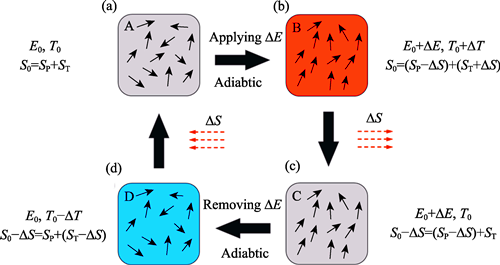
|
|
|
Effect of Ionized Amino Acid on the Water-selective Permeation through Graphene Oxide Membrane in Pervaporation Process
DONG Shurui, ZHAO Di, ZHAO Jing, JIN Wanqin
2022 Vol. 37 (4): 387–394
 Abstract
Abstract(
389 )
 HTML
HTML(
34)
 PDF
PDF(3092KB)(
640
)
Introduction of ionized groups into the channels of graphene oxide (GO) membrane can adsorb more water molecules through electrostatic interaction, which is expected to achieve more efficient water-selective permeation. In this work, a vacuum filtration method was adopted to introduce the ionized basic amino acid lysine (Lys) into the GO membrane to obtain the Lys(Na+)-GO composite membrane through covalent crosslinking. The terminal amino groups in Lys covalently crosslink GO through forming C-N covalent bond, thus regulating the membrane structure to make it more orderly. Meanwhile, the ionized carboxylate groups are introduced into GO channels. Compared with unionized lysine, the negatively charged carboxylate in ionized lysine increases the interaction with water molecules, and improves the membrane hydrophilicity. Through synergistic effect of tuning physical structure and chemical structure of GO channels, Lys(Na+)-GO composite membranes achieve the simultaneous enhancement of permeation flux and separation factor for the separation of different water/alcohol mixtures. For the pervaporation separation of ethanol/water, n-butanol/water and i-propanol/water mixtures at 40 ℃ with alcohol concentrations of 90%, the Lys(Na+)(10)-GO membrane (weight ratio of Lys(Na+) to GO in the extract soultion at 10) shows permeation flux of 882, 2461 and 1127 g/(m2·h) with water content reaching 95.38%, 99.11% and 99.42%, respectively.
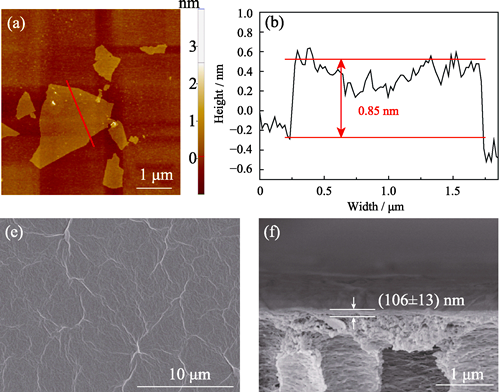
|
|
|
Removal of Uranium (VI) from Acidic Aqueous Solution by Fluorapatite
MA Lei, HUANG Yi, DENG Hao, YIN Hang, TIAN Qiang, YAN Minghao
2022 Vol. 37 (4): 395–403
 Abstract
Abstract(
414 )
 HTML
HTML(
31)
 PDF
PDF(2396KB)(
746
)
Removal of uranium (VI) from uranium (VI) containing waste water is urgently needed with the global nuclear energy exploitation. The present work completed synthesis of fluorapatite and removal of uranium (VI). Fluorapatite was synthesized using calcium fluoride, calcium pyrophosphate and calcium hydroxide as the raw materials. The fluorapatite before and after adsorption of uranium (VI) was characterized. The experimental results show that, at condition of 308 K, pH=3, solid-liquid ratio of 0.12 g/L, equilibrium time of 120 min and initial uranyl ion concentration of 100 mg/L, the adsorption capacity of uranium (VI) by fluorapatite reaches 655.17 mg/g. Adsorption process of uranium (VI) by fluorapatite is in accordance with the pseudo-second-order kinetics and Langmuir isotherm adsorption model. Adsorption of uranium (VI) by fluorapatite is a spontaneous and endothermic reaction. The removal of uranium (VI) by fluorapatite is ascribed to surface mineralization. After uranium (VI) is absorbed, a new phase of meta-autunite [Ca(UO2)2(PO4)2·6H2O] is generated on the surface of fluorapatite. The meta-autunite can maintain high stability in the pH≥3 aqueous solution. Above results indicate that fluorapatite can be used as a promising mineralizer for purification and solidification of uranium (VI) containing waste water.
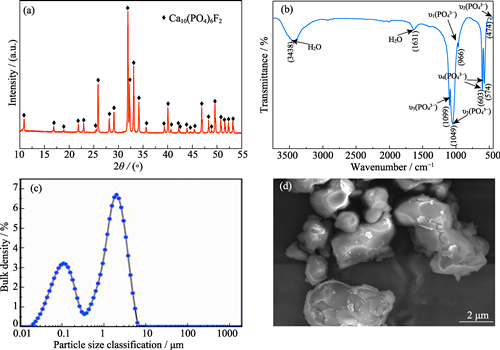
|
|
|
Gold Nanoparticles Supported on Silica & Titania Hybrid Mesoporous Spheres and Their Catalytic Performance Regulation
MA Hui, TAO Jianghui, WANG Yanni, HAN Yu, WANG Yabin, DING Xiuping
2022 Vol. 37 (4): 404–412
 Abstract
Abstract(
445 )
 HTML
HTML(
35)
 PDF
PDF(10246KB)(
987
)
In order to exploit energy sources (like photocatalytic water splitting for hydrogen production) and protect environment (like organics degradation), supported noble metal catalysts have made considerable progress in terms of design, fabrication, and theory. Herein, based on the specific morphology and structure of dendritic mesoporous silica nanospheres (DMSNs), TiO2 nanoparticles (NPs) were introduced into the channels via Sol-Gel method, developing dendritic mesoporous silica&titania nanospheres (DMSTNs). Then, amino groups (-NH2) were grafted onto DMSTNs surfaces by organic modification technology. Finally, ultrasmall gold (Au) NPs were anchored onto the as-prepared DMSTNs-NH2 through impregnation method and sodium borohydride (NaBH4) reduction. DMSTNs supported Au NPs catalysts could be successfully constructed, as verified by different methods. Under simulated sunlight for splitting water, the amount of produced H2 by the brand-new catalysts and the corresponding rate are 69.08 µmol·g-1 and 13.82 µmol·g-1·h-1, respectively, roughly. seven times of that of the contrast sample (DMSNs supported Au NPs). Without light irradiation, the apparent kinetic constant of p-nitrophenol reduction by the as-prepared catalysts is 6.540×10-3 s-1, about 17 times higher than that of the reference (0.372×10-3 s-1). ln conclusion, DMSTNs supported Au NPs exhibit good multifunctional catalytic activity.
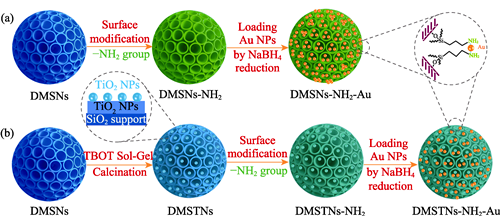
|
|
|
One-dimensional Sub-stoichiometric W3O8 Nanowires Filled Carbon Nanotubes
WU Qiuqin, YAO Fenfa, JIN Chuanhong, ZHENG Yifan
2022 Vol. 37 (4): 413–419
 Abstract
Abstract(
304 )
 HTML
HTML(
17)
 PDF
PDF(6909KB)(
670
)
Nanostructured sub-stoichiometric transition metal oxides hold promising applications in many areas, while challenge still remains towards their precisely controlled synthesis, particularly for those ultrafine nanowires. In present work, a carbon nanotube (CNT) inner growth based on two-step synthetic approach was adopted to achieve one-dimensional sub-stoichiometric tungsten oxides. Ammonium tetrathiotungsten((NH4)2WS4)) were encapsulated into the inner cavity of carbon nanotubes, which were thermally decomposed into tungsten oxides inside the CNTs. Characterizations confirm that the CNT-filling products are ultrafine one-dimensional W3O8 nanowires, that appears 1.23-1.93 nm in width (corresponding to four-five arrays of tungsten atomic column) and up tens of microns in length (close to that of CNTs). The non-noticeable size-dependent lattice parameters of the W3O8 nanowires and the large nanowire-CNT separation indicate a rather weak interaction between the filled W3O8 nanowires and host CNTs, which provides the opportunity to separate and probe the intrinsic properties of these ultrafine 1D W3O8 nanowires. Nevertheless, the proposed synthetic method is extendable to achieve other 1D transition metal oxides.
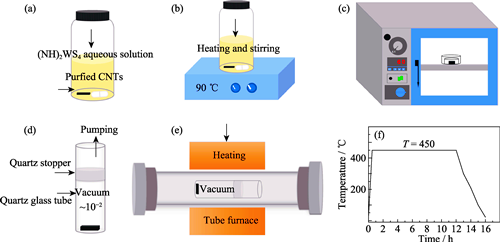
|
|
|
Response of 2D SiC/SiC Composites Resistivity to Service Environments
WEI Tingting, GAO Xiguang, SONG Yingdong
2022 Vol. 37 (4): 420–426
 Abstract
Abstract(
451 )
 HTML
HTML(
27)
 PDF
PDF(12829KB)(
1180
)
The resistivity characteristics of 2D SiC/SiC composites were studied experimentally. In the oxygen-free environment, the resistivity increases when temperature decreases. With curve fitting, the mapping relationship between resistivity and temperature is established. After oxidation at 1300 ℃ in the air for 20 and 60 h, the conductivity of composites is greatly reduced due to the oxidation of the PyC interface and the SiC matrix. The degree of oxidation was characterized by the content of SiO2, and the quantitative relationship between resistivity and oxidative damage was obtained. The changes in resistivity and stress with strain are similar. In the linear segment of stress-strain curve, with few matrix cracks the stiffness is almost unchanged, and the resistivity increases slowly. In the non-linear section, the resistivity rate and stiffness increase quickly because crack increases rapidly. They eventually stabilize when the increase in cracks slows down.
|
|
|
Preparation and Characterization of Bioactive Glass-Manganese Dioxide Composite Scaffolds
SHI Jixiang, ZHAI Dong, ZHU Min, ZHU Yufang
2022 Vol. 37 (4): 427–435
 Abstract
Abstract(
423 )
 HTML
HTML(
28)
 PDF
PDF(14108KB)(
785
)
Inflammation in bone defect after being implanted scaffold is related to oxidative stress, which is caused mainly by higher concentration of hydrogen peroxide (H2O2). Manganese dioxide (MnO2) can catalyze H2O2 decomposition to decrease excessive H2O2 in the surrounding environment of scaffolds. Furthermore, the oxygen (O2) generated by the decomposition of H2O2 can alleviate the hypoxia caused by insufficient blood supply in bone defects, which is conducive to bone tissue regeneration. Here, a simple redox method was proposed to deposit MnO2 particles on the surface of 3D printed bioactive glass (BG) scaffolds for the preparation of BG-MnO2 composite scaffolds (BGM), which endows BG-MnO2 scaffolds with the ability of H2O2 scavenging and O2 supplying simultaneously. The results showed that the MnO2 content deposited on the surface of BGM scaffolds was increased with the increase of potassium permanganate concentration in the reaction solution, and the compressive strength of BGM scaffolds was increased with the increase of MnO2 content. However, porosity and degradation rate of these scaffolds with or without MnO2 remained the same. More importantly, BGM scaffolds can continuously catalyze the decomposition of H2O2 to produce O2 in H2O2 environment. When BGM with different Mn content scaffolds (BMG5 and BGM9) catalyzed the decomposition of H2O2 to produce O2 in 2 mmol/L H2O2 solution, the saturated oxygen concentration in the solution could reach 8.4 and 11 mg/L, respectively. In vitro cell experiments showed that BGM scaffolds could promote the proliferation and alkaline phosphatase activity of rabbit bone marrow mesenchymal stem cells. Hence, BGM scaffolds show great potential in bone regeneration.

|
|
|
Dentin Remineralization Induced by Micro-nano Bioactive Glass Spheres
TANG Jieyin, WANG Gang, LIU Cong, ZOU Xuenong, CHEN Xiaofeng
2022 Vol. 37 (4): 436–444
 Abstract
Abstract(
365 )
 HTML
HTML(
16)
 PDF
PDF(5623KB)(
769
)
Occlusion of dentine tubules may reduce or eliminate dentin hypersensitivity. Here, micro-nano bioactive glass spheres (MNBGs) with various sizes and sodium alginate-phosphate buffer solution were used to prepare bioactive glass pastes (MNBGP) for dentin desensitization. Through mineralization on the surface of dentin samples in vitro, the bonding ability of different pastes with dentin, as well as the ability to induce dentin remineralization and occlude dentin tubules in vitro, was investigated. The results indicated that the MNBGP could be tightly combined with the dentin interface, and the MNBGs with smaller particle sizes were more uniformly distributed on the surface of the demineralized dentin slices. MNBGP could well mineralize in artificial saliva (AS) to form apatite (HA), induce dentin remineralization, and occlude dentin tubules, which resulted in thickening HA layer, formed on the surface of demineralized dentin slices, increased with the prolonged mineralization time, up to 5-10 μm after 28 d dentin remineralization. The size of bioactive glass microspheres had a certain impact on its ability to induce remineralization. When the particle size was equal to the diameter of the exposed dentin tubules, it could better occlude the dentin tubules. All data indicate that MNBGP has potential application for dentin hypersensitivity treatment.
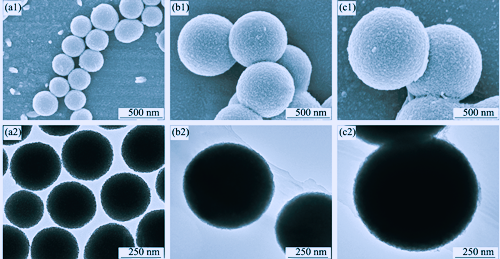
|
|
|
Reversible Conversion between Space-confined Lead Ions and Perovskite Nanocrystals for Confidential Information Storage
ZHANG Guoqing, QIN Peng, HUANG Fuqiang
2022 Vol. 37 (4): 445–451
 Abstract
Abstract(
357 )
 HTML
HTML(
22)
 PDF
PDF(6225KB)(
717
)
Luminescent materials have been widely used in confidential information protection and anticounterfeiting. Luminescent lead halide perovskite nanocrystals, which can be converted from the lead source through a two-step method, are attractive candidates for information encryption and decryption. Herein, the reversible conversion between the invisible lead-organic framework and the luminescent MAPbBr3 nanocrystals is achieved, together with their further application on information storage by inkjet printing technology. The lead ions are embedded into the metal-organic frameworks through coordination with the 2-methylimidazole linkers. The inherent confined distribution of lead ions facilitates the in-situ growth of perovskite nanocrystals in the second step without the assistance of external bulky ligands. The recorded information was firstly encrypted by the lead organic frameworks, which is invisible under ambient and UV light. After reacting with methylammonium bromide, the perovskite nanocrystals are in-situ formed, and the information becomes readable under UV light. Using methylammonium bromide and water as the decryption and encryption reagents could also switch on/off the luminescence, therefore, realizing the confidential information storage.
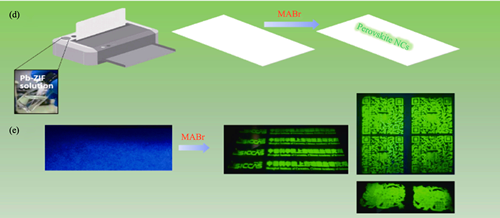
|
|
|
Microstructure and Corrosion Behavior of Brazed Joints of SiC/SiC Composites and Hastelloy N Alloy Using Cu-Ni Alloy
WANG Hongda, FENG Qian, YOU Xiao, ZHOU Haijun, HU Jianbao, KAN Yanmei, CHEN Xiaowu, DONG Shaoming
2022 Vol. 37 (4): 452–458
 Abstract
Abstract(
357 )
 HTML
HTML(
27)
 PDF
PDF(2744KB)(
778
)
SiC fibers reinforced SiC ceramic matrix composites were brazed to Hastelloy N alloy using Cu-2.67Ni (mass percentage) alloy. The obtained joints were corroded in FLiNaK molten salt at 800 ℃for 100 h. Microstructure evolution and corrosion behavior of joints were characterized. Alloy elements, e.g. Ni, Cr and Mo, diffuse from Hastelloy N alloy into Cu-Ni joint seam, while the Si element in SiC/SiC composites diffuses into joint seam even the Hastelloy N alloy. Cr element enriches near the interface between SiC composites and joint alloy to form discontinuity interlayer, which acts as the active metal instead of Ni. Higher temperature contributes to both the diffusion process and the erosion of SiC by Ni, and lower temperature would lead to the incomplete fusion of brazing fillers. The diffusion of elements during the brazing changes the composition of the joint seam and Hastelloy N alloy, which caused the deterioration of corrosion resistance of alloy. The selective corrosion of Cr and Si, supported by thermodynamic calculation, results in the corrosion of both joint seam and alloy.
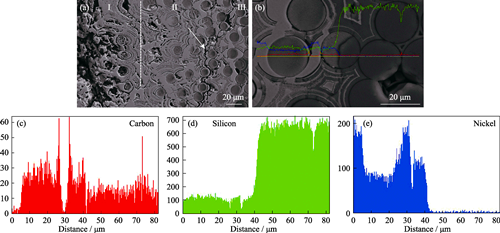
|
|
|
Porous SiC Ceramic Matrix Composite Reinforced by SiC Nanowires with High Strength and Low Thermal Conductivity
RUAN Jing, YANG Jinshan, YAN Jingyi, YOU Xiao, WANG Mengmeng, HU Jianbao, ZHANG Xiangyu, DING Yusheng, DONG Shaoming
2022 Vol. 37 (4): 459–466
 Abstract
Abstract(
701 )
 HTML
HTML(
44)
 PDF
PDF(1868KB)(
1397
)
Porous design of SiC composites with lightweight, high strength and low thermal conductivity can be obtained by constructing porous silicon carbide nanowires (SiCNWs) network and controlling chemical vapor infiltration (CVI) process. The SiCNWs network with an optimized volume fraction (15.6%) and uniform pore structure was prepared by mixing SiCNWs and polyvinyl alcohol (PVA) firstly. SiCNWs reinforced porous SiC ceramic matrix composite (SiCNWs/SiC) with a small uniform pore can be obtained by controlling the CVI parameters. The morphology of the grown SiC matrix, from the spherical particles to the hexagonal pyramid particles, can be influenced by the CVI parameters, such as temperature and reactive gas concentration. The strength of the SiCNWs/SiC ceramic matrix composites reaches (194.3±21.3) MPa with a porosity of 38.9% and thermal conductivity of (1.9± 0.1) W/(m·K), which shows the toughening effect and low thermal conductivity design.
|
|
|
Effects of Residual Stresses on Strength and Crack Resistance in ZrO2 Ceramics with Alumina Coating
LI Haiyan, HAO Hongjian, TIAN Yuan, WANG Changan, BAO Yiwang, WAN Detian
2022 Vol. 37 (4): 467–472
 Abstract
Abstract(
302 )
 HTML
HTML(
15)
 PDF
PDF(3035KB)(
642
)
By covering a thin Al2O3 coating on ZrO2 substrate, compressive stress caused by the mismatch of thermal expansion coefficients between the coating and substrate was introduced in the surface layer of Al2O3-ZrO2 pre-stressed ceramics (marked as ACZS pre-stressed ceramics). Vickers indentation test was carried out to check the crack resistance in the surface layer and substrate influenced by the residual stresses. The enhancement of the crack resistance in surface layer results in a high flexural strength and excellent damage tolerance. Both theoretical analysis and experimental results show that the compressive stress and crack resistance in the surface layer increase with the increasing ratio of the cross-sectional area of ZrO2 substrate to Al2O3 coating. Due to the residual compressive stress existing in Al2O3 coating, a high flexural strength of (1207±20) MPa was measured for ZrO2 specimens coated with 40 μm Al2O3. The flexural strength is 32% higher than that of monolithic ZrO2, and about triple of the value of Al2O3. Meanwhile, compared to ZrO2, the ACZS pre-stressed ceramics exhibit superior thermal shock resistance.
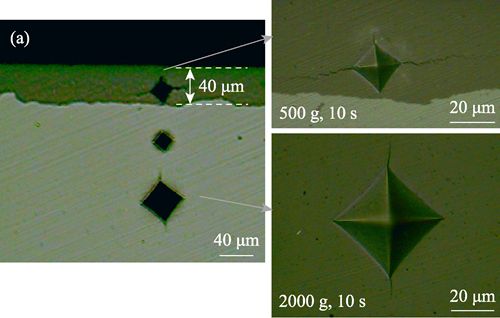
|
|